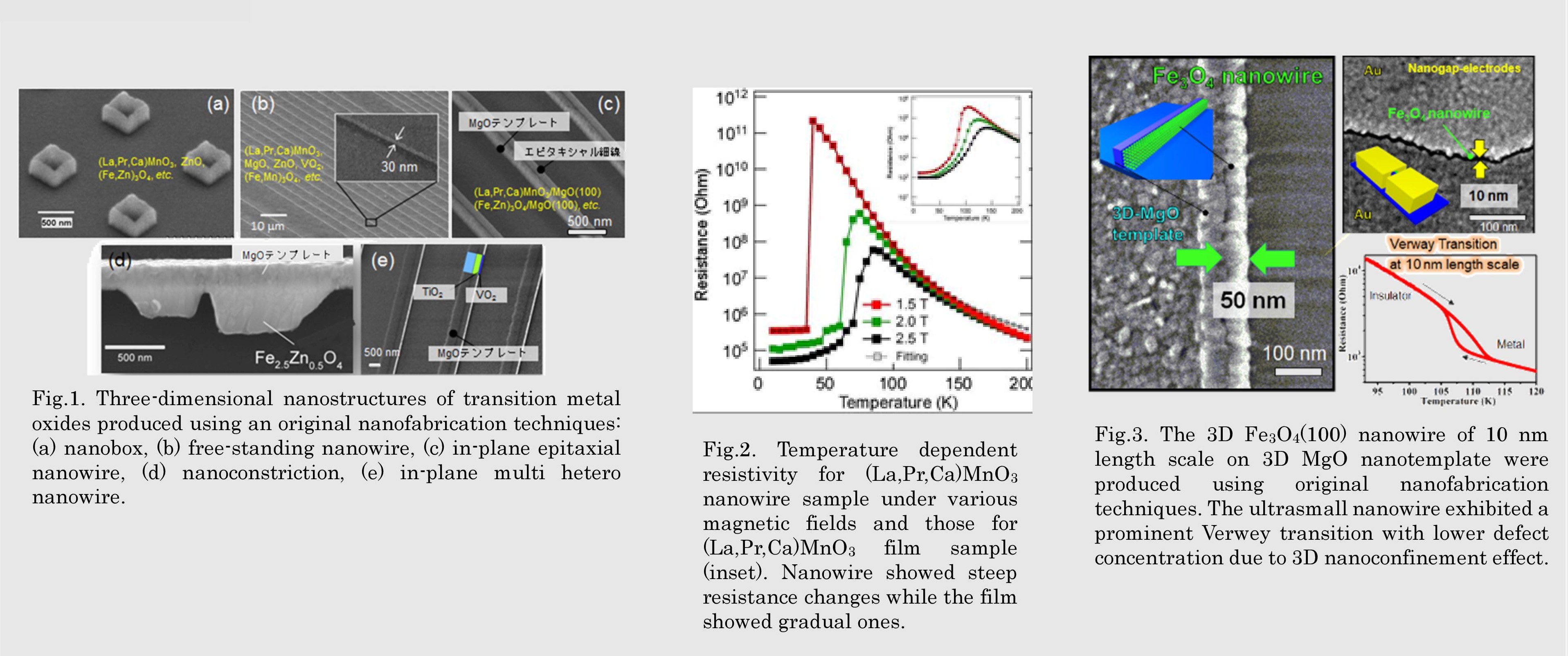SANKEN(ISIR)
The Institute of Scientific and Industrial Research, Osaka University
大阪大学
産業科学研究所

LAST UPDATE 2017/02/26
-
研究者氏名
Researcher Name服部梓 Azusa HATTORI
准教授 Associate Professor -
所属
Professional Affiliation大阪大学産業科学研究所
3次元ナノ構造科学分野
The Institute of Scientific and Industrial Research, Osaka University
Department of Three-Dimensional Nanostructure Science -
研究キーワード
Research Keywords3次元ナノ構造科学
原子精度立体造形技術
強相関酸化物ナノ物性
Three-dimensional nanostructure science
Atomically-ordered nanostructure fabrication technique
Nanoscale property of strongly correlated electron system
- 研究テーマ
Research Subject -
立体造形技術を用いたナノ領域物性研究
Nanoscale physical properties on the three-dimesionally-architected structures
研究の背景 Background
ナノ構造作製技術は、物質開発とデバイス作製を可能とするテクノロジーです。なぜなら物性を決める電子、スピン、電荷などには集団系に由来したナノサイズの特性長が存在し、試料サイズを1-10 nmと微小化して特性長と同等程度に迫ると、純粋化した物性の取り出し、言い換えると機能最少塊にアクセスが可能となるためです。そのため試料をナノメートルサイズまで縮小すると、マクロサイズでは埋没していた性質が顕在化し、ナノメートル領域での特異構造に起因する特性が現れます。
Nanostructuring is a vital approach to innovate novel material properties and device manufacturing. When the sample size becomes a few-a few tens nm scale, the superior functionalities, such as profound resistance change, steep magneto-resistance and so on, occur due to the spatial confinement effect. Therefore, the nanostructured sample can provide intrinsic information from the governing body of the phenomena owing to subtle interplay of spin, charge, orbital, and lattice degrees of freedom.
研究の目標 Outcome
強相関酸化物では転移過程で発生する10-100 nmサイズのナノ電子相が巨大応答の本質を担っており、ナノ構造化により単一ナノ電子相の物性を抽出するが可能です。独自技術により人工制御したナノ超構造体を作製し、ナノスケールの物性の解明、機能の任意制御や増大化を目指しています。また、強相関酸化物に限らず、マクロサイズに比べて圧倒的に優れた機能の抽出と操作を実現するための、形状・次元性・サイズを精密に制御したナノ構造体の作製技術開発を行っています。
Since the inhomogeneity of electronic phases in the form of nanoscale spatial electronic separation was discovered, the physical properties of the strongly correlated materials are considered to be dominated by competing nanoscale electronic phases. To mastermind nano-specific properties in strongly correlated transition metal oxides, artificially-controlled nanostructures are produced using an original nanofabrication technique and their physical properties are comprehensively investigated.
研究図Research Figure

Fig.2. Temperature dependent resistivity for (La,Pr,Ca)MnO3 nanowire sample under various magnetic fields and those for (La,Pr,Ca)MnO3 film sample (inset). Nanowire showed steep resistance changes while the film showed gradual ones.
Fig.3. The 3D Fe3O4(100) nanowire of 10 nm length scale on 3D MgO nanotemplate were produced using original nanofabrication techniques. The ultrasmall nanowire exhibited a prominent Verwey transition with lower defect concentration due to 3D nanoconfinement effect.
文献 / Publications
Nano Lett., 19, (2019) 5003, ACS Appl. Electr. Mat., 1 (2019) 82, Jpn. J. Appl. Phys., 57 (2018) 085503, Appl. Phys. Express, 10 (2017) 115001, J. Appl. Phys. 119 (2016) 125102, Surf. Sci., 644 (2016) 86, Nano Lett., 15 (2015) 4322, Appl. Phys. Express, 7 (2014) 045201, Appl. Phys. Lett., 103 (2013) 223105
研究者HP
- a-hattori
 sanken.osaka-u.ac.jp
sanken.osaka-u.ac.jp - http://www.sanken.osaka-u.ac.jp/labs/bis/